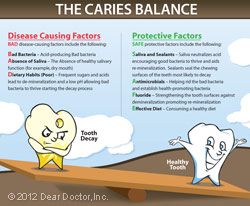Taking the Stress Out of Dentistry for Kids
How to Make Sure Your Child is at Ease in the Dentist's Chair
(Continued)
What You Don't Know May Hurt You
Many people don't know dental disease (tooth decay) can begin as early as two months of age. If people understood more about early oral health prevention, maybe tooth decay would not remain the most common chronic disease of childhood throughout the world. And what really hurts is that it's essentially preventable. Ouch!
Almost one out of four babies gets infected with their parent/caregiver's acid-producing oral bacteria. For thousands of years these tooth-decay-causing culprits have been passed from generation to generation. They survive and thrive in saliva, adhering to teeth and turning the sugars we eat into tooth-destroying acid. They need simple carbohydrates to survive and in our sugar-loving society, these germs can really go to town. Most people aren't born with soft teeth. The bacterial acid dissolves the enamel crystals of the teeth until holes (cavities) result.
Preventing transmission of these bacteria to your baby is easier than you may think. Don't put utensils or pacifiers into your baby's mouth that you've licked or used and don't share toothbrushes. Remember, too, if your teeth and gums are healthy you most likely won't transmit unhealthy bacteria to your children. If you have dental disease and untreated tooth decay, don't kiss your baby on the lips.
Before Tooth Decay Occurs

If the goal is setting our children up for low-stress dental visits, then we need to identify babies at high risk before tooth destruction occurs. The American Academy of Pediatric Dentistry (AAPD) defines any tiny little white spot on a tooth or other early signs of decay in a child under three, as evidence of the beginning of severe dental disease.
By identifying these high-risk children early, it's not only possible to prevent the process from starting, but also to reverse the early stages of tooth decay — without drilling — by using a medical approach to dental disease. By evaluating your child's diet, oral hygiene habits, teeth, and fluoride exposure, along with the family's history of dental disease, your child's risk for tooth decay can be determined in minutes. Based on this risk assessment, recommendations can be made for healthy oral and dietary habits and other preventive measures, and a healthy oral environment can be established — preventing and even reversing early tooth decay.
Keeping Out of the Cavity Zone
Depending on the age of your child and how many teeth have already erupted, fluoride varnish may be advised. A tiny amount is painted on the teeth in a thin layer. This releases fluoride, which strengthens and protects the enamel. A landmark evidence-based study established that fluoride varnish application for young children along with oral health education cuts the chance of getting cavities in half. The medical community has started to get onboard and some pediatricians have joined dentists in providing this early preventive service for infants and toddlers.
But, Once In The Cavity Zone…
If your child already has a cavity or two, these need to be treated promptly. This usually involves removing the decay and replacing the damaged tooth structure with a filling material. Sometimes temporary fillings can be placed to buy some time until a young patient is able to be fully cooperative. Dentists have many tricks up our sleeves to make things go smoothly — the most common being distraction techniques that help children imagine happy things in their active minds. Don't be surprised to find your dentist singing to relax your children to keep them happy! Describing dental instruments euphemistically, in easily understood child-friendly language, also decreases fears of the unknown. For example, the “tooth tickler” is an instrument for exploring decay in teeth; “Mr. Thirsty” suctions away saliva; and “sleepy juice” is for anesthetizing teeth, putting them to sleep for just a little while. Nitrous oxide (so-called laughing gas) used properly can be wonderful in soothing nerve-racking thoughts.
Giving Stress the Boot
The goal of making dentistry stress-free for kids is highly commendable. Today dentistry emphasizes a team effort — child, parent/caregiver and dental health professionals — working together to make oral health not only readily achievable, but also fun and stress-free. When you take your child to their new dental home, make sure to ask any questions you might have; modern pediatric dentistry welcomes and encourages the exchange of ideas.
It's also important to begin the interaction early so every facet of your child's oral health and dental development can be monitored and timely advice given. Ultimately, preventive dentistry and healthy oral and dietary habits will get your child as close to stress-free dentistry as possible.


